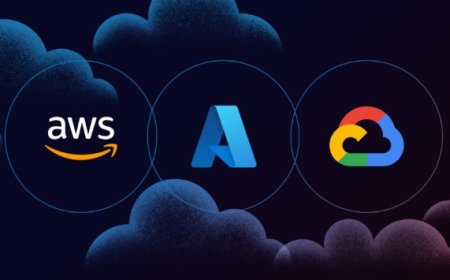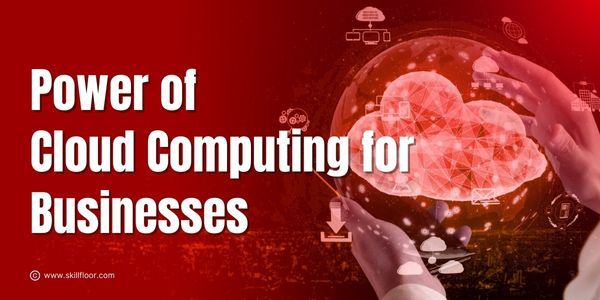Cloud Computing Concepts: A Friendly Guide
Explore the future of cloud computing in this friendly guide. Discover key concepts and stay ahead in the rapidly evolving digital landscape

In today's digital age, the term "cloud computing" is becoming increasingly common. But what exactly does it mean? In this blog, we will demystify the concept of cloud computing and explain its key concepts in a friendly and accessible manner
What is Cloud Computing?
One of the key advantages of cloud computing is its ability to provide on-demand access to computing resources. Users can quickly and easily access the services they need, such as storage space or virtual machines, without the need to invest in and maintain their own physical infrastructure. This scalability allows businesses to scale up or down based on their requirements, paying only for the resources they use.
Cloud computing enables users to access their data and applications from anywhere, at any time, using any device with an internet connection. This flexibility and mobility empower businesses and individuals to work remotely, collaborate seamlessly, and access their files and tools on the go. Whether it's checking emails on a smartphone, collaborating on documents through a web browser, or accessing business applications from a tablet, cloud computing enables a mobile and flexible work environment.
Cloud computing can result in significant cost savings for businesses. By eliminating the need for on-premises infrastructure, organizations can reduce capital expenditure on hardware, maintenance, and upgrades. Instead, they can leverage cloud services on a pay-as-you-go model, only paying for the resources and services they consume. This cost-effective approach allows businesses to focus their financial resources on other strategic initiatives and investments
On-Demand Resource Provisioning
One of the fundamental concepts of cloud computing is on-demand resource provisioning. This means that users can quickly and easily scale their computing resources up or down based on their needs. Whether you require more storage space, processing power, or software applications, cloud computing allows you to obtain these resources with just a few clicks, eliminating the need for lengthy hardware procurement processes.
Pay-as-You-Go Mode
Cloud computing often follows a pay-as-you-go model, which means that users only pay for the resources they actually use. This pricing model provides cost efficiency and flexibility, as organizations can avoid upfront investments in hardware and software licenses and instead pay for the services on a subscription basis or based on usage.
Virtualization
Virtualization provides resource optimization by enabling the consolidation of multiple virtual machines onto a single physical server. This consolidation eliminates the need for dedicated hardware for each application or service, leading to significant cost savings in terms of hardware procurement, maintenance, and power consumption. By making more efficient use of hardware resources, virtualization helps businesses maximize their return on investment and minimize infrastructure-related expenses.
Virtualization offers unparalleled flexibility and agility. It allows businesses to quickly provision new virtual machines or scale up existing ones to meet changing workload demands. This flexibility empowers organizations to respond promptly to business needs, adapt to market dynamics, and deliver services in a timely manner. Virtualization also facilitates the migration of virtual machines between physical servers, enabling workload balancing, high availability, and seamless disaster recovery.
Managing physical infrastructure can be complex and time-consuming. Virtualization simplifies this process by providing centralized management tools that allow administrators to monitor and control virtual machines from a single interface. This streamlined management approach reduces administrative overhead and enables more efficient allocation of IT resources. It also allows for easy software updates, patching, and maintenance without disruption to the underlying applications and services.
Scalability and Elasticity
Cloud computing offers unparalleled scalability and elasticity. Scalability refers to the ability to scale computing resources up or down to meet changing demands. Whether your business experiences a sudden spike in traffic or needs to expand its operations, cloud computing allows you to quickly adjust your resource allocation. Elasticity, on the other hand, goes a step further by automatically provisioning and deprovisioning resources based on real-time demand, ensuring optimal resource utilization and cost savings.
Data Security and Privacy
Cloud service providers prioritize data security and privacy. They implement robust security measures, such as encryption, firewalls, and access controls, to protect sensitive data from unauthorized access. Additionally, they adhere to strict data privacy regulations and industry standards to ensure that user data is handled with care and confidentiality.
Reliability and Disaster Recovery
Cloud computing offers high reliability and disaster recovery capabilities. With data replicated across multiple servers and data centers, the risk of data loss due to hardware failures or natural disasters is significantly reduced. Cloud service providers also implement backup and recovery mechanisms to ensure that data can be quickly restored in case of any unforeseen events.
Cloud Service Models
Cloud computing offers various service models to cater to different needs. The three main types are:
Infrastructure as a Service (IaaS): With IaaS, users can rent virtualized computing resources, such as servers, storage, and networks, from a cloud service provider. This model allows businesses to have more control and flexibility over their infrastructure, as they are responsible for managing the operating systems, applications, and data.
Platform as a Service (PaaS): PaaS provides a complete development and deployment environment for building and running applications. Users can focus on developing their software without worrying about the underlying infrastructure. The cloud service provider manages the hardware, operating systems, and runtime environments, while users have control over the applications and data.
Software as a Service (SaaS): SaaS is a software distribution model where applications are hosted by a cloud service provider and accessed over the internet. Users can use the software without having to worry about installation, maintenance, or infrastructure management. Popular examples of SaaS include email services, customer relationship management (CRM) software, and productivity suites.
Hybrid and Multi-Cloud Deployments
Many organizations adopt a hybrid or multi-cloud approach to leverage the benefits of different cloud service providers and deploy their applications and data across multiple platforms. Hybrid cloud combines both public and private cloud infrastructures, allowing businesses to take advantage of the scalability and cost-effectiveness of public clouds while keeping sensitive data and critical applications within a private cloud or on-premises infrastructure.
Internet of Things (IoT) and Edge Computing
The emergence of the Internet of Things (IoT) has further accelerated the growth of cloud computing. IoT devices generate massive amounts of data that need to be processed, stored, and analyzed. Cloud computing provides the necessary infrastructure and capabilities to handle IoT data, enabling real-time insights and decision-making. Edge computing, a paradigm that brings computation closer to the devices generating data, complements cloud computing by reducing latency and improving response times for IoT applications.
As the digital landscape continues to evolve, cloud computing will play an increasingly vital role in empowering businesses and individuals to harness the power of technology. Its scalability, flexibility, security, and cost-effectiveness make it a game-changer in the way we store, process, and utilize data. By embracing the benefits of cloud computing, organizations can drive innovation, improve efficiency, and stay ahead in the digital age.
In a nutshell, Cloud computing has revolutionized the way we store, access, and process data. It offers a range of benefits, including on-demand access to resources, flexibility and mobility, cost savings, and scalability. With cloud computing, businesses and individuals can leverage powerful computing resources without the need for on-site infrastructure, enabling them to focus on their core competencies and drive innovation. The cloud has become an integral part of our digital ecosystem, providing a foundation for technological advancements, data-driven insights, and seamless collaboration. As the demand for storage, computing power, and software applications continues to grow, cloud computing will play an increasingly vital role in meeting these needs and shaping the future of technology. Embracing cloud computing is not only a smart business decision but also a pathway to unlocking new opportunities, enhancing efficiency, and staying competitive in the digital age.





























































